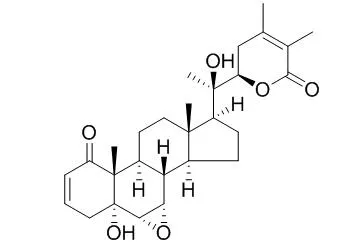| In vitro: |
| Drug Des Devel Ther. 2017 Jun 22;11:1859-1870. | | Molecular docking, QSAR and ADMET studies of withanolide analogs against breast cancer.[Pubmed: 28694686 ] | Withanolides are a group of pharmacologically active compounds present in most prodigal amounts in roots and leaves of Withania somnifera (Indian ginseng), one of the most important medicinal plants of Indian traditional practice of medicine. Withanolides are steroidal lactones (highly oxygenated C-28 phytochemicals) and have been reported to exhibit immunomodulatory, anticancer and other activities.
METHODS AND RESULTS:
In the present study, a quantitative structure activity relationship (QSAR) model was developed by a forward stepwise multiple linear regression method to predict the activity of Withanolide Analogs against human breast cancer. The most effective QSAR model for anticancer activity against the SK-Br-3 cell showed the best correlation with activity (r2=0.93 and rCV2 =0.90). Similarly, cross-validation regression coefficient (rCV2=0.85) of the best QSAR model against the MCF7/BUS cells showed a high correlation (r2=0.91). In particular, compounds CID_73621, CID_435144, CID_301751 and CID_3372729 have a marked antiproliferative activity against the MCF7/BUS cells, while 2,3-dihydrowithaferin A-3-beta-O-sulfate, withanolide 5, Withanolide A, withaferin A, CID_10413139, CID_11294368, CID_53477765, CID_135887, CID_301751 and CID_3372729 have a high activity against the Sk-Br-3 cells compared to standard drugs 5-fluorouracil (5-FU) and camptothecin.
CONCLUSIONS:
Molecular docking was performed to study the binding conformations and different bonding behaviors, in order to reveal the plausible mechanism of action behind higher accumulation of active Withanolide Analogs with β-tubulin. The results of the present study may help in the designing of lead compound with improved activity. | | Mol Neurobiol. 2018 Apr;55(4):2725-2739. | | Attenuation of Glutamate-Induced Excitotoxicity by Withanolide-A in Neuron-Like Cells: Role for PI3K/Akt/MAPK Signaling Pathway.[Pubmed: 28447311 ] | Glutamate-induced excitotoxicity is one of the major underlying mechanisms for neurodegenerative diseases. Efforts are being made to treat such conditions with an array of natural compounds that can modulate the release of glutamate or the underlying mechanisms associated with it. Withania somnifera extract has potent pharmacologic activity similar to that of Korean Ginseng tea and is used to treat several neuronal disorders. However, to date, little efforts have been made to evaluate individual constituents of this plant for neurodegenerative disorders.
METHODS AND RESULTS:
Present study was carried out to investigate Withanolide A, one of the active constituents of Withania somnifera against glutamate-induced excitotoxicity in retinoic acid differentiated Neuro2a neuroblastoma cells. The results indicated that glutamate treatment for 2 h induced death in cells that was significantly attenuated by pre-treatment with MK-801 (specific NMDA receptor antagonist) and different concentrations of Withanolide A. Withanolide A abated the glutamate-induced influx of intracellular calcium and excessive ROS production significantly. Further on, glutamate treatment resulted in increased levels of pro-apoptotic and decreased levels of anti-apoptotic proteins, and these protein levels were normalized by various doses of Withanolide A.
CONCLUSIONS:
All of these protective effects were partly due to inhibition of MAPK family proteins and activation of PI3K/Akt signaling. Thus, our results suggest that Withanolide A may serve as potential neuroprotective agent. |
|






 Cell. 2018 Jan 11;172(1-2):249-261.e12. doi: 10.1016/j.cell.2017.12.019.IF=36.216(2019)
Cell. 2018 Jan 11;172(1-2):249-261.e12. doi: 10.1016/j.cell.2017.12.019.IF=36.216(2019) Cell Metab. 2020 Mar 3;31(3):534-548.e5. doi: 10.1016/j.cmet.2020.01.002.IF=22.415(2019)
Cell Metab. 2020 Mar 3;31(3):534-548.e5. doi: 10.1016/j.cmet.2020.01.002.IF=22.415(2019) Mol Cell. 2017 Nov 16;68(4):673-685.e6. doi: 10.1016/j.molcel.2017.10.022.IF=14.548(2019)
Mol Cell. 2017 Nov 16;68(4):673-685.e6. doi: 10.1016/j.molcel.2017.10.022.IF=14.548(2019)